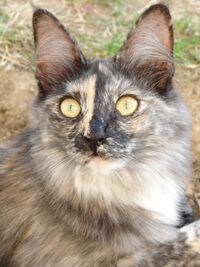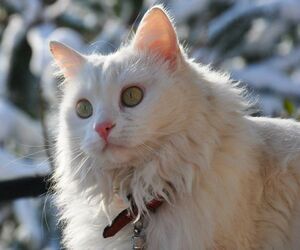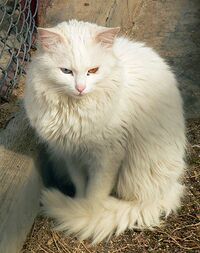قط أنغورا تركي
| Turkish Angora | |
|---|---|
Turkish Angora cat at the Atatürk Forest Farm and Zoo in Ankara. The zoo breeds and sells Turkish Angora cats.[1] | |
| أسماء بديلة | |
| Ankara[2] | |
| بلد الأصل | |
| معيار السلالة | |
| الاتحاد الدولي للقطط | : المعيار |
| جمعية مربي القطط | : المعيار |
| جمعية القطط العالمية | : المعيار |
| الجمعية الأمريكية لمربي القطط | : المعيار |
| جمعية القطط الكندية | : المعيار |
قط أنغورا تركي :
قط الأنجورا التركى (بالتركية: Ankara kedisi) اصل هذه السلالة هي الانجورا (الانقورا) من مدينة أنقرة المشهورة بالماعز ذو الشعر الناعم جدا. واصل الانجورا تركي (Turkish Angora) ويحتمل بأن أصل هذه السلالة من قطط ليبيا القديمة وكل السلالات الإيرانية من الانجورا والتي بدأت في الانقراض واستبدلت بالسلالة الإيرانية طويلة الشعر وهنا حل التساؤل هل هو انقورا ام شيرازى ام فارسي وفي مسابقات القطط ظلت بريطانيا غير معترفة بالانجورا التركي. يتميز القط الانجورا التركى بفروة كثيفة عليا كاللبدة حول الرقبة والصدر وخفيفي الجزء الأسفل ولهذا فأن مسح الانجورا بالفرشاة أسهل بكثير. الانجورا الأصلي هو الأبيض، الأسود، الرمادي، الأزرق الدخاني.
رأس متوسط الحجم أذنان كبيرتان، عنق ناعم وجميل وجود فراء غزير حول الرقبة ويخف في النصف الأسفل بذيل طويل فاخر يحركه القط لأعلى يكاد يلمس رأسه.العيون على شكل لوزة زرقاء أو خضراء أو برتقالية أو حتى عين واحدة زرقاء والعين الثانية خضراء أو برتقالية. وجود الفراء الأبيض والعيون الزرقاء متصل بالقدرة على السمع بسبب وجود الجينات (W), فإن وجود عين زرقاء يدل على أن القط أصم من الجهة التي تحتوي على العين الزرقاء فإن كانت هناك عين أخرى خضراء أو برتقالية تكون الأذن الموجودة على هذه الجهة قادرة على السمع. مع أنه هنالك الكثير من القطط ذات العيون الزرقاء والفراء الأبيض لديها سمع طبيعي، والقطط الصماء يستطيعون العيش بصورة طبيعية إن بقيت داخل المنزل. الطباع جيد السلوك ودود وذكى سكونه يعطيه مظهر أبو الهول وأيضا هي الآن من التراث الوطنى التركى وكانت تقدم هذه القطط كهدايا للعائله المالكة وقد قامت الحكومة التركية في عام 1940 بوضع برنامج لنشر السلالات وتحسين انتاجها.
. . . . . . . . . . . . . . . . . . . . . . . . . . . . . . . . . . . . . . . . . . . . . . . . . . . . . . . . . . . . . . . . . . . . . . . . . . . . . . . . . . . . . . . . . . . . . . . . . . . . . . . . . . . . . . . . . . . . . . . . . . . . . . . . . . . . . . . . . . . . . . . . . . . . . . . . . . . . . . . . . . . . . . . .
السمات

Appearance
The Angora has a silky coat that covers a long muscular body.[3] Though it is known for a shimmery white coat and posh tail, Turkish Angoras can display a variety of coat colours,[4] with the only disallowed coats being chocolate, lavender, or colourpoint.[3] The Angora's head is small to medium in size with a smooth wedge. The body is long and slender with good fineness of the bone.[3]
Eyes are large and almond shaped. The colour may be blue, green, amber, yellow, as well as heterochromatic. Ears are pointed, large and wide-set. The eyes are almond shaped and the profile forms two straight planes. The plumed tail is often carried upright, perpendicular to the back.[3]
السلوك
Turkish Angoras are playful, intelligent, athletic and involved. They bond with humans, but often select a particular member of a family to be their constant companion, whom they are very protective of.[4]
الصحة
The gene responsible for blue eyes and white coat in the Angora can cause deafness.[5] There have been reports of kittens suffering from ataxia as well as adult cats with hypertrophic cardiomyopathy.[5]
Genetic variations
Breeders in Turkey feel that the cat's fine-boned version of its natural breed is unrepresentative of the true Turkish cats, which are much sturdier. American "Turkish" Angoras have only a minimal remnant of the original Atatürk Forest Farm and Zoo DNA, and are only "purebred on paper".[6]قالب:Self-published source[7]قالب:Self-published source
A genetic study of pedigree cat breeds (using DNA taken from pedigreed cats in the U.S. and Europe) and worldwide random-bred populations showed the Turkish Van as a distinct population from the Turkish Angora despite their geographical association. The Turkish Angora was grouped with the pedigreed Egyptian Mau and random-bred Tunisian cats. Turkish random-bred cats were grouped with Israeli random-bred cats while the Turkish Van was grouped with Egyptian random-bred cats.[8] However, the UC Davis studied only American cat fancy registered Angoras rather than the "true" Turkish Angora or Ankara Kedisi directly from Turkey, and especially from the Ankara Zoo.[6]قالب:Self-published source[7]قالب:Self-published source
A genetic study published in 2012[9] included a few cats imported from Turkey. The study found that "Turkish- versus USA-originating Turkish Angoras ... are resolved as separate breed populations."[9] The American Turkish Angoras are categorised as descendants of European random-bred cats, and cats imported from Turkey "were assigned to the Eastern Mediterranean" group.[9]
In popular culture
Mewsette, the protagonist of Warner Bros. and United Productions of America's 1962 animated feature film Gay Purr-ee is a Turkish Angora.[بحاجة لمصدر]
Duchess, the protagonist of Walt Disney Pictures's 1970 animated feature film The Aristocats is also a Turkish Angora and so is her kitten daughter, Marie.[بحاجة لمصدر]
Sawyer, one of the protagonists of Warner Bros.' 1997 animated feature film, Cats Don't Dance is an anthropomorphic Turkish Angora.[بحاجة لمصدر]
Father John Misty recorded the song "Goodbye Mr Blue" on his 2022 Album Chloë and the Next 20th Century about the life and death of a Turkish Angora and how it related to the loss of another relationship.[10]
References
- ^ Loeschke, S. (November 1997). "Turkish Angoras in Ankara Zoo ... or on the road investigating the Turkish Angora". Erkr.de. Archived from the original on 18 July 2011. Retrieved 17 September 2011.قالب:Self-published source
- ^ خطأ استشهاد: وسم
<ref>غير صحيح؛ لا نص تم توفيره للمراجع المسماةhurriyet_daily_news - ^ أ ب ت ث "Turkish Angora Standard" (PDF). Cat Fanciers' Association. Retrieved 1 March 2024.
- ^ أ ب Shojai, Amy (1997). For the Love of Cats. Lincolnwood, Illinois: Publications International. pp. 108–109. ISBN 0-7853-1411-3 – via Internet Archive.
- ^ أ ب "Turkish Angora". International Cat Care. Retrieved 1 March 2024.
- ^ أ ب Hartwell, Sarah. "The Domestication of the Cat". MessyBeast.com. Retrieved 21 December 2017.
- ^ أ ب Hartwell, Sarah. "The Tangled Tale of the Turkish Angora". MessyBeast.com. Retrieved 11 September 2023.
- ^ Lipinski, Monika J.; Froenicke, Lutz; Baysac, Kathleen C.; Billings, Nicholas C.; Leutenegger, Christian M.; Levy, Alon M.; Longeri, Maria; Niini, Tirri; Ozpinar, Haydar (2008). "The ascent of cat breeds: Genetic evaluations of breeds and worldwide random-bred populations". Genomics. 91 (1): 12–21. doi:10.1016/j.ygeno.2007.10.009. PMC 2267438. PMID 18060738.
- ^ أ ب ت Kurushima, J. D.; Lipinski, M. J.; Gandolfi, B.; Froenicke, L.; Grahn, J. C.; Grahn, R. A.; Lyons, L. A. (2012). "Variation of cats under domestication: Genetic assignment of domestic cats to breeds and worldwide random-bred populations". Animal Genetics. 44 (3): 311–324. doi:10.1111/age.12008. PMC 3594446. PMID 23171373.
- ^ "Goodbye Mr. Blue by Father John Misty - Songfacts". SongFacts.com. Retrieved 14 September 2022.




